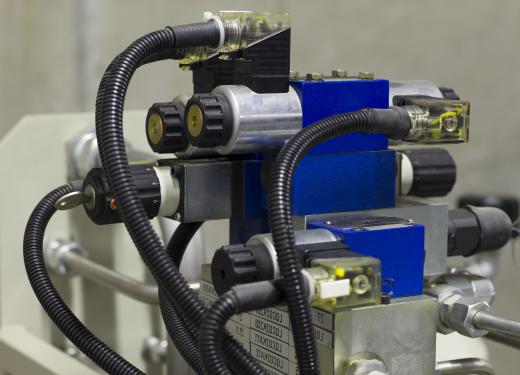A 12-volt solenoid is an electromagnetic actuation device designed to work with a 12-volt direct current (DC) or alternating current (AC) power supply. Similar in all respects to the rest of the solenoid family of actuators, the 12-volt solenoid consists of a coil of wire wrapped around a hollow, insulated core and a ferrous metal plunger, or armature, as it is often called. The coil is fixed with the free-moving plunger placed so that the end closest to the coil is adjacent the mouth of the hollow core. Unless the actuated mechanism is fitted with some form of a return mechanism, the plunger will be equipped with a return spring. These 12-volt solenoids are commonly used in automotive applications such as engine function controllers.
Solenoids are a part of the actuator family of devices that supply remote or automated activation or adjustment of secondary mechanisms. They are the simplest of the actuators, consisting only of one static and one moving part, and are available in a wide range of sizes, output, and voltage ratings. One of the commonly encountered variants of these devices is the 12-volt solenoid. These are devices that share all of the physical features of the solenoid family, but are specifically rated to operate with a 12-volt power supply. This can include both AC and DC supplies, although the direct current variant is the more common of the two.

As with all its peers, the 12-volt solenoid consists of a static coil consisting of suitably-rated copper wire wrapped around a hollow, insulated core. The two loose ends of the coil are wired into a 12-volt power supply interrupted by a control mechanism. A moving plunger constructed of an iron-based alloy is located near the coil, with one end close to the opening of the core. A return spring is mounted either around the plunger or on the actuated mechanism. This serves to reset the plunger at the end of each duty cycle.
When the control mechanism is activated and power flows to the coil of the 12-volt solenoid, a powerful magnetic field is generated around the coil assembly. Due to the ferrous metal construction of the plunger, this field has a strong attractive effect on it, pulling it rapidly towards and into the hollow coil core. The plunger is attached to the actuated mechanism by means of a linkage through which it transfers its movement. The rapid movement of the plunger thus activates the secondary mechanism, completing the first half of the duty cycle.
When the secondary device requires deactivation, the control circuit is disabled and the power ceases to flow to the solenoid coil. This causes the magnetic field to collapse and release its hold on the plunger, at which point the return spring pulls it back into its neutral position, completing the second half of the duty cycle. The 12-volt rating of these solenoids make them particularly useful in smaller, light-duty applications such as the activation of various engine and general automotive functions and irrigation systems.
